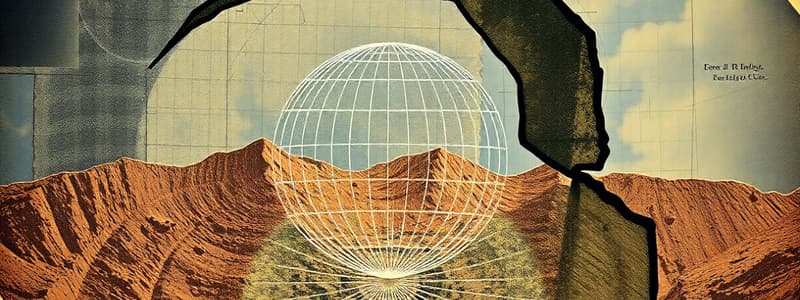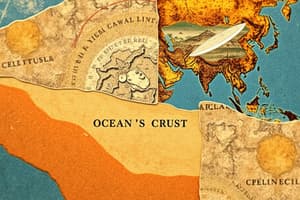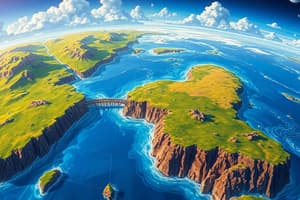Podcast
Questions and Answers
Which process primarily drives the movement of tectonic plates according to the convection current theory?
Which process primarily drives the movement of tectonic plates according to the convection current theory?
- Gravitational pull of the moon
- The Earth's rotation
- Radioactive decay in the Earth's core heating magma (correct)
- Wind patterns on the Earth's surface
What evidence supports Wegener's theory of continental drift?
What evidence supports Wegener's theory of continental drift?
- Satellite imagery showing current continental movement
- The discovery of new elements in the Earth's core
- Analysis of atmospheric pressure systems
- Matching glacial deposits across different continents (correct)
Which type of crust is generally thicker and less dense?
Which type of crust is generally thicker and less dense?
- Continental crust (correct)
- Oceanic crust
- Both are equally thick and dense
- Depends on the specific location
What geological feature is commonly associated with convergent plate boundaries where one plate is forced beneath another?
What geological feature is commonly associated with convergent plate boundaries where one plate is forced beneath another?
Which of the following characteristics is typical of rocks found near mid-ocean ridges?
Which of the following characteristics is typical of rocks found near mid-ocean ridges?
What is the primary composition of oceanic crust?
What is the primary composition of oceanic crust?
How does the age of oceanic crust vary with distance from a mid-ocean ridge?
How does the age of oceanic crust vary with distance from a mid-ocean ridge?
What is the lithosphere composed of?
What is the lithosphere composed of?
Which geological feature is associated with transform plate boundaries?
Which geological feature is associated with transform plate boundaries?
What causes the magnetic anomalies observed on either side of mid-ocean ridges?
What causes the magnetic anomalies observed on either side of mid-ocean ridges?
Where are deep earthquakes most commonly observed?
Where are deep earthquakes most commonly observed?
What is the primary driving force behind sea-floor spreading?
What is the primary driving force behind sea-floor spreading?
The Andes Mountains are an example of what type of mountain building?
The Andes Mountains are an example of what type of mountain building?
What is the Benioff zone?
What is the Benioff zone?
Which process leads to the formation of volcanic island arcs?
Which process leads to the formation of volcanic island arcs?
What type of plate boundary is the San Andreas Fault?
What type of plate boundary is the San Andreas Fault?
The Himalayas were formed by what type of plate boundary interaction?
The Himalayas were formed by what type of plate boundary interaction?
What is the primary cause of the elevated topography of mid-ocean ridges?
What is the primary cause of the elevated topography of mid-ocean ridges?
Which layer of the Earth is responsible for the movement of tectonic plates?
Which layer of the Earth is responsible for the movement of tectonic plates?
What is 'paleomagnetism'?
What is 'paleomagnetism'?
Flashcards
Crust
Crust
The Earth's outermost layer, thin compared to the mantle and core.
Mantle
Mantle
Layer beneath the crust that makes up 82% of Earth's volume.
Core
Core
The Earth's innermost layer, very dense and hot.
Lithosphere
Lithosphere
Signup and view all the flashcards
Continental crust
Continental crust
Signup and view all the flashcards
Oceanic crust
Oceanic crust
Signup and view all the flashcards
Continental drift
Continental drift
Signup and view all the flashcards
Pangaea
Pangaea
Signup and view all the flashcards
Sea-floor spreading
Sea-floor spreading
Signup and view all the flashcards
Conservative Plate Boundary
Conservative Plate Boundary
Signup and view all the flashcards
Convection current theory
Convection current theory
Signup and view all the flashcards
Dragging theory
Dragging theory
Signup and view all the flashcards
Hotspot
Hotspot
Signup and view all the flashcards
Paleomagnetism
Paleomagnetism
Signup and view all the flashcards
Sea-floor spreading
Sea-floor spreading
Signup and view all the flashcards
Subduction zones
Subduction zones
Signup and view all the flashcards
Benioff zone
Benioff zone
Signup and view all the flashcards
Ocean ridges
Ocean ridges
Signup and view all the flashcards
Volcanic island arcs
Volcanic island arcs
Signup and view all the flashcards
Trench outer rise
Trench outer rise
Signup and view all the flashcards
Study Notes
- The Earth is composed of layers, including a thin crust, a large mantle (82% of Earth's volume), and a dense core.
- These layers increase in density towards the center due to temperature and pressure effects.
The Lithosphere
- The lithosphere is the Earth's upper surface layer, consisting of the crust and the upper mantle.
- It extends to a depth of about 70 kilometers.
- The Earth's crust is divided into continental crust and oceanic crust.
- Continental crust is characterized by silica and aluminum, often forming granitic rocks when combined with oxygen.
- Oceanic crust is mainly basaltic rock, rich in silica, iron, and magnesium.
Comparison of Oceanic and Continental Crust
- Continental crust has a thickness of 35-70 km and is very old, mainly over 1500 million years.
- Oceanic crust has a thickness of 6-10 km and is very young, mainly under 200 million years.
- Continental crust is lighter in color and has an average density of 2.6, while oceanic crust is darker and denser, with an average density of 3.0.
- Continental crust consists of numerous rock types, often containing silica and oxygen. Granitic rock is most common.
- Oceanic crust consists of few rock types, mainly basaltic.
Continental Drift
- In 1912, Alfred Wegener proposed the idea of continental drift.
- Wegener suggested that continents were once joined in a supercontinent called Pangaea, which broke apart about 250 million years ago.
- Initial debate surrounding Wegener's theory lacked a mechanism to drive continental drift.
Sea Floor Spreading
- In the mid-20th century, Harry Hess proposed that convection currents drive magma up to crack the crust.
- Research in the 1960s on rock magnetism supported Hess's theory.
- Rocks at the Mid-Atlantic Ridge showed alternating magnetic orientations, and rocks farther from the ridge were older.
Plate Tectonics Theory
- In 1965, J. Wilson linked continental drift and seafloor spreading into the theory of plate tectonics.
- Evidence for plate tectonics includes the distribution of earthquakes, changes in Earth's magnetic field, and the fit of continents like a jigsaw puzzle.
- Fossil and geological matches across continents support the theory.
Plate Boundaries
- Earthquake zones help define major and minor plates.
- Plate boundaries are divided into divergent (constructive), convergent (destructive and collision), and conservative types.
- Divergent boundaries, where new crust forms, are commonly found in mid-ocean ridges and feature shallow earthquakes.
- Convergent boundaries cause deep-sea trenches to form when one plate is subducted, and deep earthquakes are common.
- Transform faults occur where plates slide past each other, causing shallow earthquakes (e.g., San Andreas Fault).
- Continent-continent collisions cause crushing and folding, leading to mountain formation.
Movement of Plates
- The convection current theory states hot magma rises to the surface, spreads at mid-ocean ridges, then cools and sinks back into the Earth's interior.
- The dragging theory states older, cold, and heavy plate edges are dragged or subducted.
- Hotspots, or plumes of lava, rise vertically through the mantle and can cause movement by exerting a drag force on the plates.
Sea-Floor Spreading Explained
- R.S. Dietz and H.H. Hess proposed sea-floor spreading to explain continental drift.
- Oceanic crust is created from the mantle at mid-ocean ridges.
- Confirmation came from the discovery of symmetrical magnetic anomalies by F.J. Vine and D.H. Matthews.
Paleomagnetism
- When lava cools, magnetic grains in the rock record the direction of the Earth's magnetic field at the time of cooling, known as paleomagnetism.
- Elevated ridges are comprised of hotter, less dense rock.
Spreading Rates
- Spreading rates vary throughout the mid-ocean ridge system.
- Slow-spreading ridges have a pronounced rift, while fast-spreading ridges lack a central rift.
- Mid-ocean ridges are broken into segments by transverse faults.
Subduction Zones
- Subduction zones form when an oceanic plate collides with another plate and is pushed into the upper mantle.
- Oceanic crust remains cooler and denser.
- The amount of subduction generally balances the amount of crust production at mid-ocean ridges.
- Subduction zones dip at angles between 30° and 70°.
- Older crust tends to dip more steeply.
Evidence for Subduction
- Evidence includes the existence of deep-sea trenches, folded sediments, Benioff zones, and the distribution of temperature at depth.
- Deep-sea ocean trenches are found at subduction zones and are long, narrow depressions in the ocean floor.
- The depth can range from 6000 meters to 11,000 meters.
Benioff Zone
- The Benioff zone occurs on a plane that dips at an angle of about 45° away from the underthrusting oceanic plate.
- Earthquakes on the Benioff zone extend to a maximum depth of about 680 kilometers.
Fold-Mountain Building
- Plate tectonics is associated with mountain building where linear or arcuate chains are formed on land.
- Where an ocean plate meets a continental plate folding can occur.
- Where two continental plates meet, folding and buckling can form mountains like the Himalayas.
Himalayas Formation
- The Himalayas formed by the collision of the Eurasian and Indian plates.
- Oceanic crust pieces thrusting onto continental crust is known as Ophiolite.
- Crustal thickening leads to the uplift of the Himalayan mountain range.
Andes Formation
- The Andes were formed by the subduction of oceanic crust under continental crust.
- The Andes contain many active volcanoes.
- Sediments accumulated on the continental shelf and slope.
Ocean Ridges
- Ocean ridges are giant submarine mountain chains, 60,000 kilometers long, with crests that rise 2 to 3 kilometers above the ocean floor.
- These mid-ocean ridges are where new lithosphere is created.
Volcanic Island Arcs
- Island arc systems are formed when oceanic lithosphere is subducted beneath oceanic lithosphere.
- They are located at the margins of oceans.
- Typical arc characteristics are low bulge (the 'trench outer rise'), trench that marks the plate boundary largely filled with sediments, and faults on the trench's outer slope.
- Subduction complex forms from the descending slab, potentially forming landforms like Trinidad, Tobago and Barbados.
- The overriding plate contains a volcanic island arc.
Studying That Suits You
Use AI to generate personalized quizzes and flashcards to suit your learning preferences.




